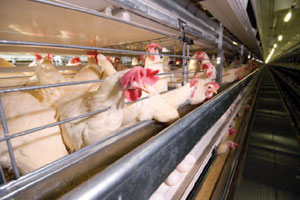California voters call for changes in livestock housing
Supporters of the controversial Proposition 2 are calling its passage on Nov. 4 a precedent-setting victory.
With an estimated 63 percent of California's voters casting ballots in favor of the measure, the new law will affect millions of animals in the nation's largest agricultural state.
Also known as Standards for Confining Farm Animals, Proposition 2 requires California producers to make major alterations to livestock housing systems by 2015. Specifically, egg-laying hens, veal calves, and pregnant sows must have enough room to lie down, stand, turn around, and fully extend their limbs. For instance, a hen must be able to fully spread both wings without touching the side of an enclosure or other hen.
Violators could be charged with a misdemeanor and fined up to a thousand dollars, imprisoned, or both.
The AVMA praised California voters for taking an interest in the welfare of production animals. And now that the proposition has been passed into law, the Association hopes veterinarians and animal scientists are consulted when the housing regulations are written—a message the AVMA was quick to communicate to the state and national media outlets.

"(V)eterinarians and animal welfare scientists must be involved in its implementation to make sure that resulting changes in animal housing actually improve conditions for the animals they are intended to help," said Dr. W. Ron DeHaven, AVMA CEO.
"If we're not careful, animal health and welfare problems could be precipitated that are as significant as the concerns Proposition 2 aspires to address," Dr. DeHaven cautioned.
Multiple factors must be looked at when considering how to house an animal to ensure its well-being, according to Dr. Gail C. Golab, director of the AVMA Animal Welfare Division. "We agree that more attention needs to be paid to the behavioral well-being of production animals," she said. "In doing so, we don't want to be singularly focused on just providing additional space, as is the case with Prop 2.
"For example, moving laying hens to free-range production systems may allow them to engage in more species-typical behaviors, but it also increases the hens' risks of illness and injury because it increases their exposure to disease vectors and predators."
Dr. Golab says the AVMA can help California producers protect the welfare of their animals by providing information gained from research at home and abroad on alternative production systems. "We can use this information to help avoid animal welfare pitfalls as we assist California farmers in meeting the requirements of Proposition 2," she said.
Proposition 2 advocates welcomed the victory as the eventual end to veal crates, sow gestation stalls, and battery cages in California. "Today marks a significant change in the way we view and treat farm animals and falls closer in line with public sentiments and values of compassion," said Gene Baur, president of Farm Sanctuary.

Farm Sanctuary and The Humane Society of the United States led Californians for Humane Farms, the coalition of animal protection organizations that ran the "YES on Prop 2" campaign. Several groups supported the initiative, including the California VMA and American Society for the Prevention of Cruelty to Animals.
Californians for Safe Food called the pro-Proposition 2 campaign "emotionally manipulative, dishonest, and often deceptive," however. "The special-interest group that pushed Prop 2 will now go back to Washington and leave it to California's farmers, veterinarians, regulators, and lawyers to interpret what this poorly conceived and vaguely worded initiative actually means for the real people it affects," according to a statement the group issued.
Critics of the new law claim it will lead to changes that actually harm animals instead of benefit them. They also say the costs of implementing the new systems will put many poultry farms out of business as well as make food less safe and more expensive, and move production out of California.
Although California is not a major veal producer and gestation stalls are already being phased out, the state is the nation's fifth largest egg producer, meaning the poultry industry there will be impacted most by the new law.
California is the latest state to hold a referendum on livestock housing. Voters in Florida passed legislation in 2002 phasing out gestation stalls by 2008. Arizona voters adopted a similar measure in 2006, ending the use of gestation and veal calf stalls in their state by 2012.
Unlike the earlier referendums, the California initiative gained national attention. Talk show host Oprah Winfrey dedicated an entire episode to discussing Proposition 2. Both sides pumped millions of dollars into getting their messages out.
The AVMA's positions on the housing of layer chickens, veal calves, and pregnant sows as well as Prop 2 information and resources are available on the AVMA Web site.